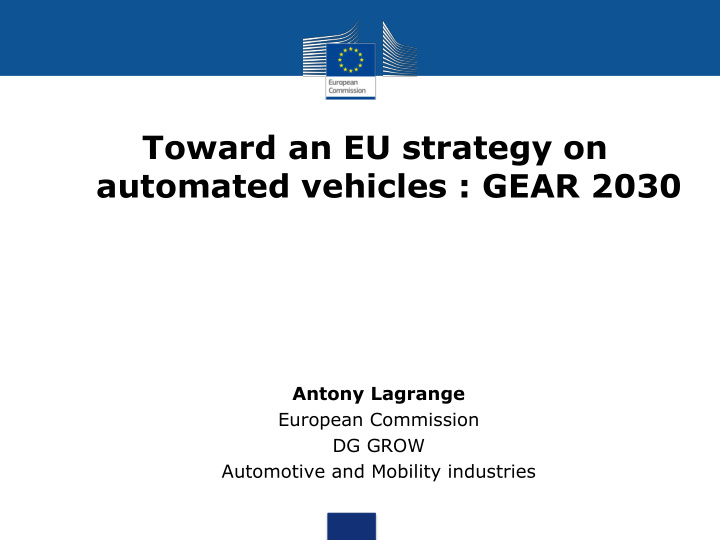



Toward an EU strategy on automated vehicles : GEAR 2030 Antony Lagrange European Commission DG GROW Automotive and Mobility industries
EU legal system for automated/connected vehicles • EU type-approval mandatory for new cars produced in series from 1998, motorcycles from 2003 and trucks/buses from 2014 • Fully harmonized requirements (more than 70 functions) . More and more based on international regulations (UN) for the approval of vehicle functions (coordination at EU level). • Comprehensive: Member States shall not prohibit, restrict or impede the registration, sale, entry into service or circulation on the road of vehicles... covered by Directive 2007/46/EC, if they satisfy the requirements of the latter. • Special ad-hoc assessment for new technologies (Art 20 of Directive 2007/46/EC) pending new requirements. • Flexibilities for Member States on small series or individual approval (e.g. for testing). 2
Why an EU strategy? • Requested by Member States : https://english.eu2016.nl/documents/publi cations/2016/04/14/declaration-of- amsterdam • Vehicles are coming • Cross-cutting/ interlinked issues • Many initiatives • Need for a common vision: • What are we talking about? • When will these systems come for testing/consumers? • How do we get there? • Who is empowered to act (EU, 3 national, international level)?
Why GEAR 2030? • Objective: Comprehensive approach for the EU car sector by 2030 • 3 main focuses: decarbonization, digitization and globalization • How: gathering relevant Commissioners, Ministers and stakeholders • Recommandations for an EU roadmap on automated and connected vehicles- Three main pillars: • EU legal and policy framework, • coordinated research and financing tools, • International co-operation and support competitiveness. • Target: First recommendations for upcoming systems (2020) adopted in Feb 2017 and final long-term (2030) recommendations by September 2017. • All documents publicly available 4
An EU common vision : • "Mass market 2020 systems- vehicle with driver/operator • - Motorway (high speed): e.g. Highway pilot assist, level 2 platooning • -City (low speed): traffic jam assist, manoeuvres at low speed (e.g. parking), level 4 shuttles in some dedicated areas). • "Mass market 2030 systems: 'driverless' systems • - Driverless vehicles (driver as passenger) in cities such as shuttles in wider ranges, valet parking. • - Highly automated vehicles on motorways (levels 4 highway pilots, level 4 platoons, etc,) • 5
Convergence between automation and connectivity Fully automated 6
GEAR 2030: first recommendations on 2020 systems • Adopted in Feb 2017 covering large scale tests, road safety, connectivity, liability • No big issues for the placing on the market/tests. However shall be regulated quickly: • Data storage (black boxes) for liability assignment reasons • Vehicle legislation and traffic rules shall ensure that the driver will not misuse or will be confused by upcoming automated systems. UNECE favoured route for internaitonal vehicle regulations and traffic rules: Need to urgently finalize the work for 2020 systems (L2/3/4 automated vehicles with a driver) in WP1 and in WP29 (UN Regulation 79) as systems are already coming the market 7
GEAR 2030: Next steps including 2030 systems • Final recommendations to be adopted by the high level group on 18 October 2017. Follow up by Commission, • Will cover: testing, liability, road safety,connectivity, societal issues, data issues, road infrastructure, vehicle certification, financing issues, competitiveness and international issues. • Points of interest for UNECE: • Shift of the tasks/responsability of the driver especially for driverless • WP1: The work shall be speed up on driverless vehicles (shuttles). Some work also needed at national level (e.g. distance keeping). • WP29: New approach needed for the certification of automated vehicles, new topics (cybersecurity, data recorders, driver monitoring, sensing environment, distance keeping, etc) • For both: Coherent relashionship between the machine and the driver/other road users 8
Research and funding for CA vehicles at EU level • Development of large scale projects involving the automotive, telecom and digital sectors. • Horizon 2020 has a dedicated call for automated road transport, with a budget of over 100 million Euros over 2 years. • The Connecting Europe Facility (CEF) and the Investment Plan for Europe have important targets to stimulate C-ITS • Cooperation at the international level? 9
• Thank you for your attention! • For further information: • antony.lagrange@ec.europa.eu 10
Recommend
More recommend